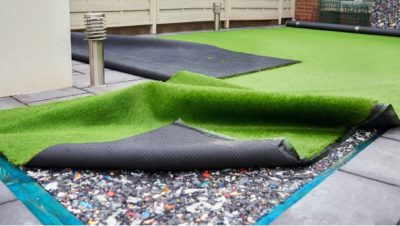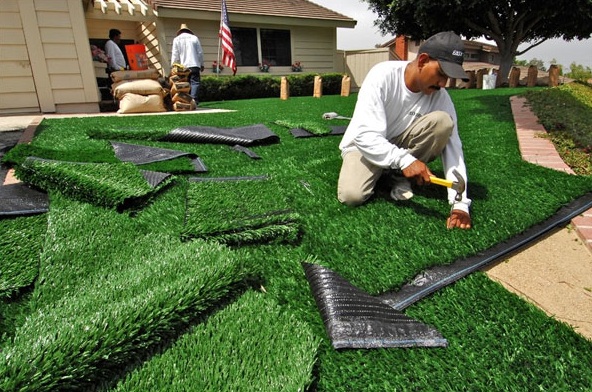Dependable Turf Installation Services in Canoga Park for Artificial Lawns
Dependable Turf Installation Services in Canoga Park for Artificial Lawns
Blog Article
Top Reasons to Consider Artificial Grass for a Low-Maintenance and lavish Backyard
As house owners increasingly look for sustainable remedies for outdoor rooms, artificial yard offers an attractive alternative to conventional lawns. The benefits expand beyond mere aesthetic appeals and sustainability; exploring the diverse ramifications of artificial lawn discloses a comprehensive technique to backyard management that values much deeper factor to consider.
Year-Round Greenery
Among one of the most substantial benefits of fabricated yard is its capacity to give year-round plant, no matter of environment problems. House owners commonly encounter obstacles in preserving a lively yard because of seasonal modifications, droughts, or heavy rains. Man-made lawn gets rid of these issues, guaranteeing a regularly lush look throughout the year.
This artificial option is engineered to endure varied climate circumstances, from sweltering summertime heat to cold winter months temperatures. Unlike natural yard, which may brown or come to be irregular during severe conditions, synthetic grass maintains its vibrant shade and texture, boosting the aesthetic appeal of any type of landscape.
Additionally, fabricated lawn is resistant to bugs and diseases that commonly affect all-natural yards. This strength adds to its long-lasting beauty, as there is no demand for chemical treatments or plant foods that can be damaging to the environment. Moreover, property owners can appreciate the visual advantages of a well-maintained grass without the cyclical obstacles posed by all-natural grass care (artificial grass installation).
Minimized Upkeep Efforts
Man-made yard considerably minimizes upkeep efforts, enabling house owners to enjoy an immaculate grass without the time-consuming tasks connected with all-natural grass care. One of the most significant advantages of synthetic lawn is the removal of normal mowing. With no requirement for a lawnmower, home owners save both time and the expense of upkeep related to this equipment.

Cleansing synthetic yard is straightforward; a basic rinse with a hose or the occasional cleaning to get rid of debris is normally enough - artificial grass. This simplicity of treatment allows property owners to invest even more time enjoying their outside areas as opposed to struggling over them. In summary, the decreased upkeep initiatives connected with man-made lawn make it an enticing choice for those seeking an attractive, problem-free lawn
Water Preservation Benefits
The considerable reduction in upkeep initiatives related to synthetic turf encompasses water preservation, making it an eco-friendly alternative for homeowners. Traditional lawns need considerable quantities of water to stay rich and lively, usually resulting in excessive water usage, particularly in arid areas. On the other hand, artificial grass eliminates the requirement for routine watering, considerably minimizing the general water intake in your lawn.
By choosing for synthetic turf, house owners can preserve hundreds of gallons of water every year. This shift not only advantages individual homes however likewise contributes to broader ecological campaigns focused on decreasing water waste. In locations experiencing water deficiency, the adoption of artificial yard can play a considerable function in mitigating the effects of dry spell and ensuring that beneficial water resources are utilized a lot more efficiently.
Furthermore, the installment of synthetic yard can assist lower local water demand, profiting the community in its entirety. With growing awareness of ecological issues, selecting synthetic yard functions as a proactive action towards sustainable landscape design, assisting to preserve natural water resources while maintaining a cosmetically pleasing outside room (artificial grass canoga park). In recap, artificial lawn presents a compelling remedy for water conservation, aligning environmental duty with contemporary landscape design requirements

Pest and Allergic Reaction Decrease
A substantial benefit of mounting synthetic turf is its capacity to reduce pests and irritants in outside areas. Conventional grass yards usually work as breeding grounds for insects such as insects, ticks, and ants, which can develop discomfort and wellness dangers for pet dogs and families. In contrast, synthetic lawn eliminates the organic product that draws in these parasites, thereby substantially decreasing their populaces in your yard.
Moreover, all-natural grass can nurture mold, plant pollen, and other irritants, which can activate allergies and respiratory system problems for delicate individuals. Artificial grass provides a cleaner atmosphere, reducing the possibility for allergenic reactions. Unlike all-natural turf, artificial lawn does not produce plant pollen, making it an outstanding alternative for allergy victims seeking to appreciate their outside rooms without the risk of flare-ups.
In addition, the lack of soil in synthetic grass indicates there is less dust and dust, further lessening airborne allergens. This low-maintenance choice not only improves the visual appeal of your backyard but likewise promotes a healthier outside setting, allowing family members to enjoy their yards without the consistent concern of allergens and pests. Therefore, artificial lawn is a calculated selection for those prioritizing comfort and wellness in their outdoor space.
Long-Term Expense Savings
Investing in artificial turf can lead to significant lasting cost savings for homeowners. While the initial investment might this website appear significant, the financial benefits gradually can be considerable. Man-made yard eliminates the need for regular lawn maintenance expenses, such as mowing, feeding, and watering. Traditional yards usually call for significant sources to keep a lavish look, especially in areas susceptible to drought or extreme weather.
In addition, the longevity of synthetic turf even more enhances its cost-effectiveness. Most top quality artificial grass items can last 15 to 25 years with very little upkeep, minimizing the requirement for replacement or substantial repair services. On the other hand, all-natural lawn may require frequent reseeding and regular treatment, which can rapidly accumulate in prices.
Energy cost savings are another critical variable. House owners can expect to see reduced water expenses, as synthetic turf does not call for watering. Furthermore, the reduction in lawn treatment services can liberate important time and sources, enabling homeowners to designate their budgets in other places.
Conclusion
In recap, synthetic yard provides numerous benefits for homeowners looking for a dynamic and low-maintenance landscape. Its capacity to offer year-round plant, paired with minimized upkeep initiatives and substantial water click here to read preservation, makes it an appealing selection. In addition, the decrease of parasites and allergens adds to a healthier outside setting. Ultimately, the long-lasting expense financial savings associated with man-made lawn strengthen its status as a sustainable and sensible option for enhancing outdoor areas.
Fabricated yard significantly reduces maintenance initiatives, permitting home owners to enjoy a beautiful yard without the lengthy tasks associated with natural grass treatment.The significant reduction in maintenance efforts linked with fabricated turf extends to water conservation, making it an ecologically friendly option see it here for homeowners. In contrast, artificial turf gets rid of the requirement for regular watering, dramatically minimizing the general water usage in your yard.
In locations experiencing water shortage, the adoption of artificial grass can play a substantial duty in mitigating the results of drought and guaranteeing that valuable water sources are made use of more effectively.
With growing recognition of environmental concerns, selecting man-made turf serves as an aggressive step in the direction of sustainable landscape design, assisting to maintain natural water resources while preserving a cosmetically pleasing outside space.
Report this page